PRINCETON, NJ -- The number of Americans who believe they are likely to contract the H1N1 virus this year has nearly doubled since early May, expanding from 20% to 36%. At the same time, substantially fewer Americans, 59%, down from 74%, are generally confident the U.S. government can handle a major outbreak of the so-called swine flu.
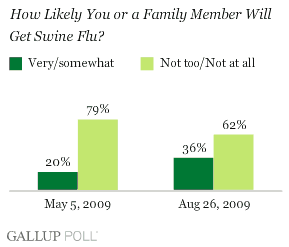
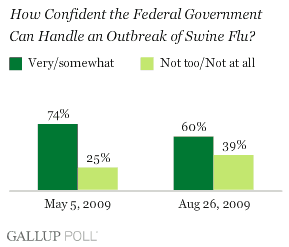
Further evidence that the public is taking the illness more seriously than they did this spring comes from the finding that a slight majority of Americans, 55%, up from 46% in May, say they would get the swine flu vaccine later this year, assuming one is available.
Currently, 60% of those with no health insurance say they would seek a vaccination, as would 64% of those covered by Medicare or Medicaid and 51% who are covered by an employer or union plan.
Also, a slightly larger majority now believes the warnings the government issued about the dangers of swine flu are real rather than exaggerated -- 61% compared with 56% in May.
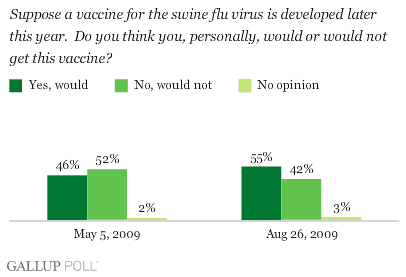
Apart from Americans' heightened belief that they or a family member are likely to contract the H1N1 virus, more also say they worried "yesterday" about the possibility. Currently 17% say they are worried, up from 8% in June, but the same as the17% found in early May.
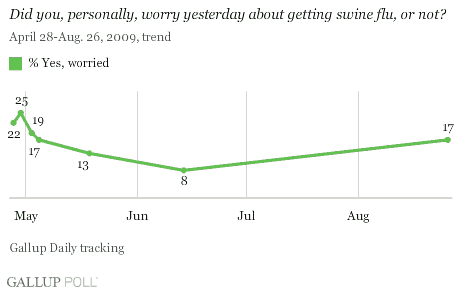
Americans 18 to 34 years of age express greater concern about contracting swine flu than those 55 and older, a consistent pattern in the Gallup trends this year. However, the younger age set is significantly less likely than older adults to believe themselves or a family member will contract the flu, and no more likely to say they will be vaccinated. Middle-aged adults show the least interest in obtaining the vaccine.
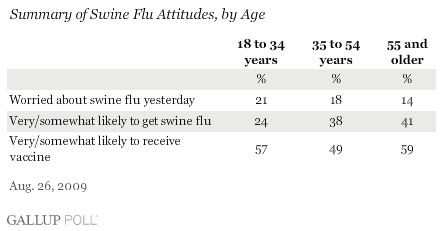
Adults with children under 18 at home are a bit more likely than those without children to say they personally worried yesterday about themselves contracting swine flu: 21% vs. 15%. At the same time, parents of minors are slightly less likely than non-parents to believe that someone in their family is likely to get the illness -- 33% vs. 38% -- and are no more likely to plan on being vaccinated.
Even medicine can be political. While Gallup finds only minor differences by gender, age, and region in the country in confidence that the federal government is prepared to handle a major outbreak of swine flu, about half of Republicans (48%) and independents (54%) are confident compared with 77% of Democrats.
The overall decline in government confidence in handling an outbreak may be due in part to a loss of confidence in the Obama administration in general. When the May poll was conducted, two in three Americans approved of the job Obama was doing as president, compared with only about half today.
Bottom Line
Public anxiety about swine flu has ebbed and flowed since the first U.S. cases came to light in late April. The percentage saying they worried about the illness initially spiked to 25%, but has since not exceeded 17%, and in June fell to 8%. Although the figure is back up to 17%, Gallup finds relatively larger increases in the percentages of Americans believing they are at risk of being sickened by the virus and planning to be vaccinated.
Taken together, these findings suggest Americans may be comforted by news reports that the virus has thus far been no more deadly than the regular seasonal flu. Nevertheless, they appear mindful that the flu, already declared a pandemic, could mutate into something more severe this fall and spread rapidly, with no definitive date set for when a vaccine will become available.
Survey Methods
Results are based on telephone interviews with 1,007 national adults, aged 18 and older, conducted Aug 26, 2009, as part of Gallup Daily tracking. For results based on the total sample of national adults, one can say with 95% confidence that the maximum margin of sampling error is ±4 percentage points.
Interviews are conducted with respondents on landline telephones (for respondents with a landline telephone) and cellular phones (for respondents who are cell phone only).
In addition to sampling error, question wording and practical difficulties in conducting surveys can introduce error or bias into the findings of public opinion polls.
Polls conducted entirely in one day, such as this one, are subject to additional error or bias not found in polls conducted over several days.
